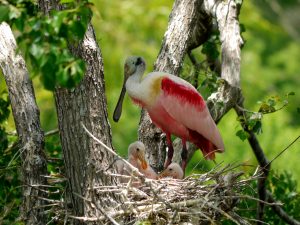Travelers on the Great River Road this season may notice they have some company.
The Great River Road National Scenic Byway follows the path of the Mississippi Flyway, a migratory route used by 35 percent of North American birds. It the biggest flyway for migratory birds and is used by 325 different species. Some bids will travel a few hundred miles on the flyway, others more than a thousand as they move from vast breeding grounds in the northern United States and Canada to wintering areas in southern states, Central America and Mexico.
The Mississippi River Valley provides food, habitat and protection for millions of birds as they make this epic twice-yearly journey. Along the route, travelers will see birds on the move, including vast flocks of geese as well as cranes, ducks, sparrows, blackbirds, thrushes and warblers.
So what’s the best way to see these beautiful creatures?
Start by visiting one of the birding locations on the route. Locks & dams and scenic overlooks along the route offer fantastic birding. See a list of these spots here. Consider bring along some binoculars and a birding book so you can identify the birds you encounter.
There are also many parks and museums of interest to bird lovers on the route.
- At the National Eagle Center in Wabasha, Minnesota you can meet real bald and golden eagles, climb in a nest or see how your strength stacks up against the national bird’s. The museum is open but pre-registration is required.
- The Upper Mississippi National Wildlife Refuge stretches for 261 miles through Illinois, Iowa, Wisconsin and Minnesota and offers some of the best birdwatching in the world during the spring and fall migrations.
- Charles, Arkansas is home to the White River National Wildlife Refuge. Over 300 lakes and ponds, the Bottomland Hardwood Forest and the White River make an ideal home for migrating birds. You’ll see bald eagles, wood ducks, prothonotary warblers and many kinds of birds native to the south.
- In Louisiana, the Jean Lafitte National Historical Park & Preserve, you’ll find more than 200 species of birds, from herons, egrets and ibis to prothonotary warblers and painted buntings. The scenery is breathtaking here with canals, forests and swamps.
Interested in learning even more? The Great River Birding Trail has specific details on birds on the rote, including the abundance of different species, nesting locations and directions to more birding spots along then northern part of the Mississippi. Click below to see maps for some of the different segments on the route.
- St. Cloud, Minn., Map – from Little Falls to Anoka (River Mile 970 to 870)
- Minneapolis and St. Paul, Minn., Map (River Mile 870 to 823)
- Red Wing, Minn., Map – from Cottage Grove to Kellogg (River Mile 823 to 755)
- La Crosse, Wis., Map – from Kellog, Minn., to New Albin, Iowa (River Mile 755 to 674)
- Prairie du Chien, Wis., Map – from New Albin, Iowa, to Sageville, Iowa (River Mile 674 to 586)
- Dubuque, Iowa, Map – from Sageville, Iowa, to Clinton, Iowa (River Mile 586 to 507)
- Burlington, Iowa, Map – from New Boston, Ill., to Keokuk, Iowa (River Mile 437 to 361)








